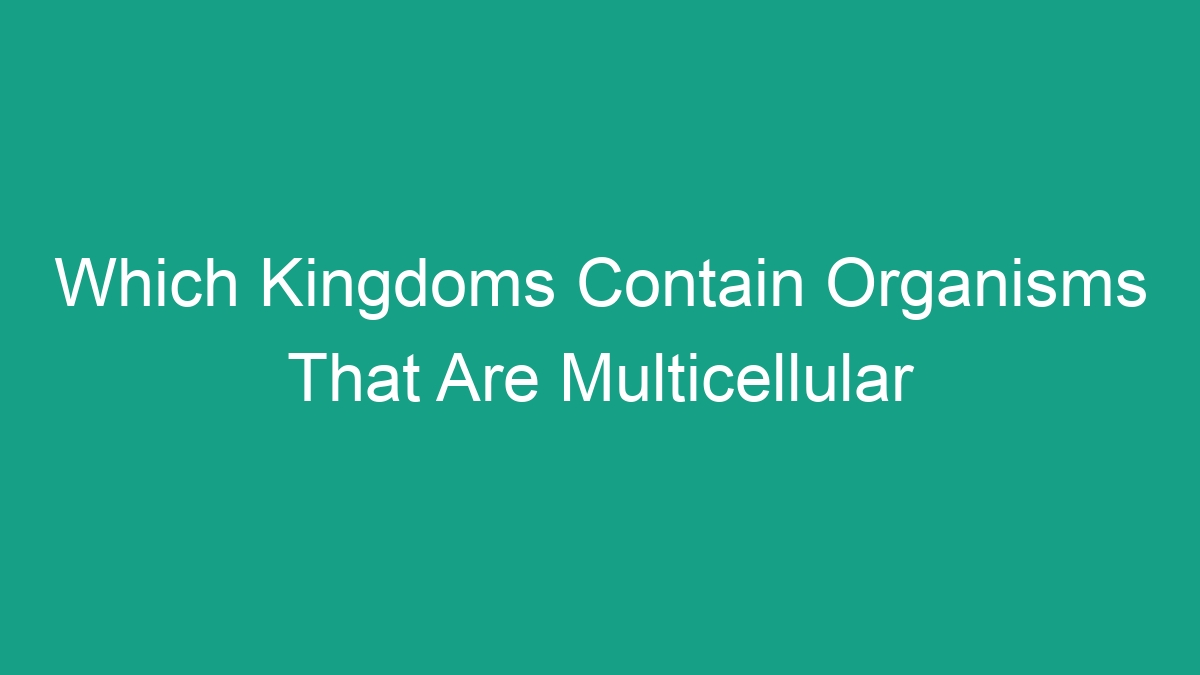
When it comes to the classification of living organisms, they are generally grouped into different kingdoms based on certain characteristics and traits. One of the key distinctions among organisms is whether they are unicellular or multicellular. Multicellular organisms are those that are composed of multiple cells that work together to form tissues, organs, and organ systems, while unicellular organisms are made up of a single cell. In this article, we will explore the kingdoms that contain multicellular organisms and the diversity of life within each of them.
1. Animalia Kingdom
The Animalia kingdom is home to a vast array of multicellular organisms, including mammals, birds, reptiles, amphibians, and many more. These organisms are characterized by their ability to move, consume other organisms for energy, and possess complex organ systems.
Key characteristics of the Animalia kingdom:
- Multicellular organisms
- Heterotrophic (obtain energy by consuming other organisms)
- Have specialized cells that form tissues, organs, and organ systems
- Most have the ability to move
Some well-known examples of multicellular organisms in the Animalia kingdom include:
| Organism | Description |
|---|---|
| Lion | A large carnivorous mammal found in various habitats across Africa and Asia. |
| Eagle | A bird of prey known for its keen eyesight and powerful beak. |
| Frog | An amphibian with the ability to live both in water and on land. |
2. Plantae Kingdom
The Plantae kingdom consists of multicellular organisms that are known for their ability to perform photosynthesis, a process by which they use sunlight, carbon dioxide, and water to produce their own food. This kingdom includes a diverse range of organisms, from towering trees to tiny mosses.
Key characteristics of the Plantae kingdom:
- Multicellular organisms with cell walls made of cellulose
- Perform photosynthesis to produce energy
- Have complex vascular systems for transporting water and nutrients
- Reproduce through spores or seeds
Examples of multicellular organisms in the Plantae kingdom include:
| Organism | Description |
|---|---|
| Oak tree | A large perennial plant with wide-spreading branches and acorns as fruits. |
| Rose bush | A woody perennial flowering plant known for its fragrant blooms. |
| Fern | A non-flowering vascular plant that reproduces via spores. |
3. Fungi Kingdom
The Fungi kingdom, although often overlooked, is also home to multicellular organisms. This kingdom includes a variety of organisms such as mushrooms, molds, and yeasts. While they may look very different from animals and plants, fungi play crucial roles in ecosystems and have unique characteristics.
Key characteristics of the Fungi kingdom:
- Mostly multicellular (though some fungi are unicellular)
- Cell walls made of chitin
- Heterotrophic, obtaining nutrients through absorption
- Reproduce through spores
Examples of multicellular fungi include:
| Organism | Description |
|---|---|
| Button mushroom | A common edible fungus found in many cuisines around the world. |
| Black mold | A type of fungus that can grow on various surfaces, often in damp environments. |
| Truffle | A highly prized fungus with a strong, distinctive flavor used in gourmet dishes. |
4. Protista Kingdom
The Protista kingdom is known for its diverse range of single-celled and multicellular organisms. While this kingdom predominantly consists of unicellular organisms such as algae and protozoans, there are also multicellular members such as seaweeds and kelp.
Key characteristics of the Protista kingdom:
- Includes both unicellular and multicellular organisms
- Some members perform photosynthesis, while others are heterotrophic
- Some have complex multicellular structures such as seaweeds
- Reproduce through various methods such as cell division and spores
Examples of multicellular organisms in the Protista kingdom include:
| Organism | Description |
|---|---|
| Green algae | A group of photosynthetic organisms that can range from single-celled to multicellular forms. |
| Kelp | A type of large brown algae that forms dense underwater forests in marine environments. |
| Red algae | A diverse group of multicellular seaweeds found in marine habitats around the world. |
Conclusion
As we’ve explored, multicellular organisms are found in several of the major kingdoms of life, including Animalia, Plantae, Fungi, and even Protista. The diversity of multicellular life on our planet is truly astounding, ranging from towering trees to microscopic fungi and seaweeds. Understanding the different kingdoms that contain multicellular organisms is essential for gaining insight into the complexity and interconnectedness of life on Earth.



